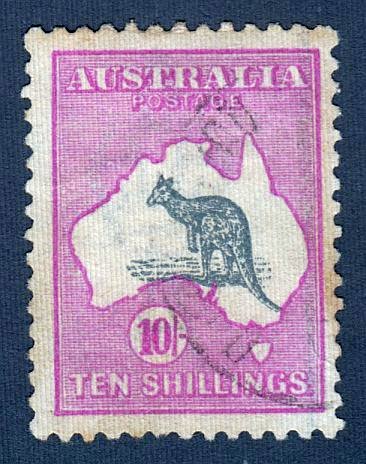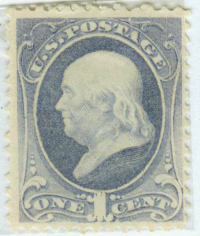
Discussion - Member to Member Sales - Research Center

Discussion - Member to Member Sales - Research Center

I anxiously looked through my album of 3 and 4 cent stamps and realize I have several that would grade similarly. I know condition is important to most collectors, but is this a real trend or a fad?

Login to Like
this post

11:23:16pm
We had a pretty good discussion of the grading system in the topic "General Philatelic Discussion," Thread "Rare Stamps and Individual Retirement Accounts?" and I also posted about it in the topic "Steamroom"

Login to Like
this post

11:42:25am
In my opinion, Thom, it will stay around where it serves a real purpose (classic and some pre-1940 US), but will soon fade into the old F, VF, XF, etc. for other US. However, I would not be surprised to see it expanded to the issues of other popular collecting countries. Software marketeers, grading entities, and some dealers have made out like bandits on this system in the past few years, and they may look for for other venues as collectors of US become more sophisticated.

Login to Like
this post
Since it costs something to 'grade and encapsulate' a stamp, I would think that you are paying more for the service than the stamp. If you think about it the cost of storing, preserving and displaying the vast majority of stamps probably exceeds the value of the stamps. Encapsulation strikes me as a fad promoted by those who stand to make money by providing the service.
As to its staying power, how well do the encapsulated classics do in the more traditional auctions?

Login to Like
this post

03:31:34pm
My seldom all that humble opinion: An expensive fad.

Login to Like
this post
Don't touch it, Thomas.
Charlie is correct except that it's a fad whose best-before date has expired.
The "buyer" population for encapsulated stamps is micrometre-small and
shrinking as I write. If you've already bought in, all I can suggest is that
you take a Valium.
John Derry

1 Member
likes this post.
Login to Like.
John,
I couldn't agree with you more. I was looking at some of those "perfect stamps" this morning on eBay and was appalled at the number of them still listed. For anyone interested, there is still a lot of swamp land down here in the Sunshine state that's for sale. Also, I heard there was another wheeler-dealer selling the Brooklyn Bridge again. Both better buys than some of those stamp lots. LOL
Mike

Login to Like
this post
you really want to see how bad some of these "grading' systems are getting ripped by collectors, stop by Stampboards and see how much they're ripping on PSE Services (and deservedly so).
These services are (IMO), nothing more than a con-job done to take collectors for lots of money for common stamps. It's not even a fad, it's a ripoff. (Sorry, that's my opinion on these kind of services.)

Login to Like
this post
This is a bit off-topic but I would like to revisit the certification issue. How do the members rate the various certification entities?
I use APS, but they will not grade an issue. APS attests to the genuineness of the stamp and describes its faults (if any). They do not grade the stamp either numerically or subjectively according to Scott. I do know other entities will numerically grade the stamp.
Les

Login to Like
this post
I don't think that an authentication service should assign a grade to a stamp. That is not the purpose of the authentication.
The grading service is totally subjective. Look at the first stamps that were given grades of 98. As explained by the service, those grades were given, because those were the best examples they had seen at the time. Years since, stamps in better condition have been graded as 98. That does not change the grade of the first ones, in poorer condition, however. That in itself devalues the entire grading system, as all grades are given conditionally that no other stamp in a better condition had been presented for grading at that time. What other recourse is there? Something like this?
- Stamp A (US #39) graded 98 in 2003
- Stamp B (US #39) graded 98 in 2009
Therefore Stamp B is worth more since it was graded above the condition of Stamp A that was given the same grade? Totally ridiculous and impossible to keep track of, in my opinion.

Login to Like
this post
Great input everyone. Based upon Michael's post, I am sure more and more post-1940 stamps will surface that could be graded 90, 95, or 98. I found several in my collection, but in 20 years from now, I am sure more people will have nice copies still in their collections. The production runs on stamps after 1940 increased, esp. beginning in 1949, to over 100 million on most 3c commemmoratives.
And another things re. condition of commonly produced items: I found a 1981 proof set of US coins when cleaning out an estate. PROOF - top condition. I could not even get $10 for it on ebay.
I will enjoy my clean, MNH copies whether they are worth 3 cents or several dollars. They are common but are beautiful works of art.

Login to Like
this post
10:51:17pm
I have seen common 3 and 4 cent commemoratives posted and sold on ebay which were graded and encapsulated. These stamps, may of which I can buy for face value or less, are selling in the neighborhood of $20 a stamp, since the stamp is MNH with a grade of SUPERB-98.
I anxiously looked through my album of 3 and 4 cent stamps and realize I have several that would grade similarly. I know condition is important to most collectors, but is this a real trend or a fad?

Login to Like
this post
They who would give up essential Liberty, to purchase a little temporary Safety, deserve neither Liberty nor Safety. -Benjamin Franklin
26 Feb 2013
11:23:16pm
re: Graded stamps after 1940
We had a pretty good discussion of the grading system in the topic "General Philatelic Discussion," Thread "Rare Stamps and Individual Retirement Accounts?" and I also posted about it in the topic "Steamroom"

Login to Like
this post
They who would give up essential Liberty, to purchase a little temporary Safety, deserve neither Liberty nor Safety. -Benjamin Franklin
27 Feb 2013
11:42:25am
re: Graded stamps after 1940
In my opinion, Thom, it will stay around where it serves a real purpose (classic and some pre-1940 US), but will soon fade into the old F, VF, XF, etc. for other US. However, I would not be surprised to see it expanded to the issues of other popular collecting countries. Software marketeers, grading entities, and some dealers have made out like bandits on this system in the past few years, and they may look for for other venues as collectors of US become more sophisticated.

Login to Like
this post

re: Graded stamps after 1940
Since it costs something to 'grade and encapsulate' a stamp, I would think that you are paying more for the service than the stamp. If you think about it the cost of storing, preserving and displaying the vast majority of stamps probably exceeds the value of the stamps. Encapsulation strikes me as a fad promoted by those who stand to make money by providing the service.
As to its staying power, how well do the encapsulated classics do in the more traditional auctions?

Login to Like
this post
Silence in the face of adversity is the father of complicity and collusion, the first cousins of conspiracy..
27 Feb 2013
03:31:34pm
re: Graded stamps after 1940
My seldom all that humble opinion: An expensive fad.

Login to Like
this post
The past is a foreign country, they do things different there.
27 Feb 2013
04:41:30pm
re: Graded stamps after 1940
Don't touch it, Thomas.
Charlie is correct except that it's a fad whose best-before date has expired.
The "buyer" population for encapsulated stamps is micrometre-small and
shrinking as I write. If you've already bought in, all I can suggest is that
you take a Valium.
John Derry

1 Member
likes this post.
Login to Like.

re: Graded stamps after 1940
John,
I couldn't agree with you more. I was looking at some of those "perfect stamps" this morning on eBay and was appalled at the number of them still listed. For anyone interested, there is still a lot of swamp land down here in the Sunshine state that's for sale. Also, I heard there was another wheeler-dealer selling the Brooklyn Bridge again. Both better buys than some of those stamp lots. LOL
Mike

Login to Like
this post

re: Graded stamps after 1940
you really want to see how bad some of these "grading' systems are getting ripped by collectors, stop by Stampboards and see how much they're ripping on PSE Services (and deservedly so).
These services are (IMO), nothing more than a con-job done to take collectors for lots of money for common stamps. It's not even a fad, it's a ripoff. (Sorry, that's my opinion on these kind of services.)

Login to Like
this post

re: Graded stamps after 1940
This is a bit off-topic but I would like to revisit the certification issue. How do the members rate the various certification entities?
I use APS, but they will not grade an issue. APS attests to the genuineness of the stamp and describes its faults (if any). They do not grade the stamp either numerically or subjectively according to Scott. I do know other entities will numerically grade the stamp.
Les

Login to Like
this post

re: Graded stamps after 1940
I don't think that an authentication service should assign a grade to a stamp. That is not the purpose of the authentication.
The grading service is totally subjective. Look at the first stamps that were given grades of 98. As explained by the service, those grades were given, because those were the best examples they had seen at the time. Years since, stamps in better condition have been graded as 98. That does not change the grade of the first ones, in poorer condition, however. That in itself devalues the entire grading system, as all grades are given conditionally that no other stamp in a better condition had been presented for grading at that time. What other recourse is there? Something like this?
- Stamp A (US #39) graded 98 in 2003
- Stamp B (US #39) graded 98 in 2009
Therefore Stamp B is worth more since it was graded above the condition of Stamp A that was given the same grade? Totally ridiculous and impossible to keep track of, in my opinion.

Login to Like
this post
10:53:03pm
re: Graded stamps after 1940
Great input everyone. Based upon Michael's post, I am sure more and more post-1940 stamps will surface that could be graded 90, 95, or 98. I found several in my collection, but in 20 years from now, I am sure more people will have nice copies still in their collections. The production runs on stamps after 1940 increased, esp. beginning in 1949, to over 100 million on most 3c commemmoratives.
And another things re. condition of commonly produced items: I found a 1981 proof set of US coins when cleaning out an estate. PROOF - top condition. I could not even get $10 for it on ebay.
I will enjoy my clean, MNH copies whether they are worth 3 cents or several dollars. They are common but are beautiful works of art.

Login to Like
this post

